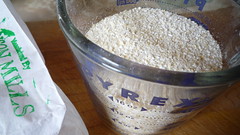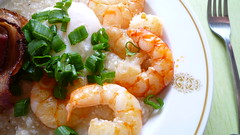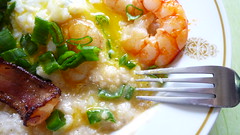Grits, Asian-American Style
 fig. a: Anson Mills coarse white grits
fig. a: Anson Mills coarse white grits
A stamped white paper bag, a Pyrex measuring cup, and some white grits.
Doesn't look like much, I know. But those aren't just any grits, they're Anson Mills antebellum coarse white grits, the grits David Chang has called "the killerest grits ever."
These grits being "the killerest," you could make them straight-up, add some salt and pepper, add a little butter, and you'd be sitting pretty, but you're not going to settle for straight-up, are you? Didn't think so.
No, you're going to follow David Chang and Team Momofuku on one of their flights of fancy. People often misunderstand the Momofuku experience as being just another example of "Asian fusion." Now, there's no question that there's some fusion going on within the Momofuku empire, but there's also quite a bit of fission. And, yes, Asian elements figure prominently. But there's a side to David Chang that's almost Kenny Shopsin-like. As far as I know, he hasn't invented any countries, then set about creating their national cuisines, but there's more imagination than one generally associates with the term fusion. The narratives are richer. They're more profane. They're also a hell of a lot funnier.
As Chang describes things, Momofuku Noodle Bar's Shrimp & Grits was a pivotal dish, because aside from the Asianesque broth that Chang used to make the grits, and that you couldn't actually see, "there was no Asian foundation, relation, or appearance to the dish. No other "noodle bar" was serving shrimp and grits."
The idea, the dream, behind the dish was to take a down-home Southern soul food classic, disarticulate it, ruminate on it, and then reanimate it in Momofuku's laboratories:
I imagined what it would be like if my ancestors had ended up in Charleston, South Carolina, a few generations before I was born. They would have eaten corn, they would have eaten grits, they would have cooked with bacon. Or, if Southerners were magically transplanted to Korea, they'd eat jook instead of grits at breakfast. And you know a people who can handle the salty power of a country ham certainly could have gotten down with kimchi. I imagined a Japanese cook making grits--you know he'd boil it in dashi and season it with soy.Chang recommends making this dish with either his Ramen Broth or his Bacon Dashi. We went with the latter a) because it's way simpler, b) because it's way cheaper to make, and c) because it's another great example of the Momofuku Philosophy at play. As Chang puts it:
I guess these were all conversations I was having with myself. I didn't want to be cooking shitty fusion food. I consoled myself by thinking about how Vietnamese cuisine and Cajun cooking adapted French techniques into something that might have looked French but tasted totally different. But it was with this dish that I decided--or accepted--that if we reached past "tradition" to create the truest and best version of a dish for our own palates, then what we were doing wasn't bullshit.
I can't overstate the significance of bacon dashi to us at Momofuku. It's not the dashi itself--though it is delicious--but the thought process that went into it. The successful transposition of bacon from Tennessee for Japanese dried and smoked fish was an important early success for us, and it continues to be a driving inspiration of how we cook.So the following are Chang's instructions (more or less verbatim), using Momofuku's Bacon Dashi.
We respect tradition and we revere many traditional flavor profiles, but we do not subscribe to the idea that there's one set of blueprints that everyone should follow.
Still can't see what all the fuss is about? Well, here goes:
 fig. b: before
fig. b: beforeMomofuku Shrimp & GritsThe resultant dish is one that's remarkably subtle, but utterly irrepressible. When I finished making the dish the first time, I remember saying to Michelle that I was surprised that the recipe didn't call for some kind of Asian-inflected sauce that you'd drizzle overtop, but then I went and took my first bite and suddenly I understood.
2 cups water
2 cups white or yellow quick-cooking grits, preferably from Anson Mills (SC)
2 cups Bacon Dashi (recipe follows)
2 tablespoons light soy sauce, such as usukuchi
kosher salt and freshly ground black pepper
8 tbsp unsalted butter, cut into pieces
1/2 pound smoky bacon, such as Benton's (TN) or North Country Smokehouse (NH), cut crosswise into 1- to 1 1/2-inch-long lardons
1 pound medium shrimp (16 to 20 count), shelled
2 tbsp grapeseed or other neutral oil, such as canola
4 freshly poached eggs
1/2 cup chopped scallions, greens and whites included
Combine the water and grits and soak the grits overnight (or for at least 8 hours) in the pot you'll cook them in.
Drain the grits, add the broth to the grits, and bring to a simmer over medium-high heat, whisking all the while. Continue to whisk for 5 minutes after the liquid simmers, then turn the heat down to low. You'll reach "first starch"--the point at which the fine corn particles thicken the liquid just enough to suspend the larger particles--after 5 minutes, and it's crucial to whisk constantly until you reach that point, and to turn the heat down immediately afterwards.
Add the soy sauce, a large pinch of salt, and some freshly ground black pepper. Keep the heat low and whisk regularly if not constantly; the grits should be thickening, undulating, and letting occasional gasps of steam bubble up and out. Soaked grits will be cooked after about 10 minutes over low heat. They're ready when they're no longer grainy, and they've become thick and unctuous.
Add the butter, stirring until it has melted and been absorbed into the grits. Taste them and add additional salt and pepper as needed. Set aside, covered to keep warm, while you get the rest of the dish in order (or serve them at once if you can't take it anymore and you just want to eat them solo).
Put the shrimp in a mixing bowl, pour the oil over them, and add a couple pinches of salt. Toss them in the oil and salt until they're coated. Set aside while you take care of the bacon.
Cook the bacon in a 12-inch cast-iron skillet over medium heat until the lardons have shrunk to about half their original size and are crispy, about 5 to 6 minutes. Remove the bacon with a slotted spoon and drain them on paper towels. Drain the bacon fat from the pan and reserve for another later use. Return the pan to the stove.
Make sure you've got your eggs poached and ready to go. They're ready? Good. Proceed.
Wipe the pan cleanish with a paper towel and turn the heat up to high. Cook the shrimp in two batches. As soon as the shrimp hit the pan, press down on them, using a bacon press, the back of a big spatula, a flattish pot lid, or a smaller pan--whatever works (we've found that a flattish pot lid works best for us). Sear the shrimp for about 1 minute on the first side. Watch the shrimp closely. As the gray-pink flesh of the raw shrimp gradually turns white in the side pressed against hot pan, and when that white line creeps about 40% of the way up the shrimp, flip them and press down on the second side. Sear that side only long enough to brown them a bit, about 30-45 seconds. Ideally, they should be just slightly shy of cooked when you pull them from the pan--they'll continue to cook after they come out of the pan. Use your judgment. Cook them a little longer if you prefer, but, remember, nobody likes overcooked shrimp. Nobody. Not even you.
Make up plates for 4. Shallow soup plates are ideal. Start with a big helping of grits, nestle a poached egg in the middle, and arrange 1/4 of the bacon, 1/4 of the shrimp, and 1/4 of the scallions in separate piles around the edge. Serve at once. Savor.
Serves 4.
Momofuku Bacon Dashi
2 x 3-by-6-inch pieces of kombu
8 cups water
1/2 pound smoky bacon, such as Benton's (TN) or North Country Smokehouse (NH)
Rinse the kombu under running water, then combine it with the water in a medium saucepan. Bring the water to a simmer over medium heat, then turn off the stove. Let steep for 10 minutes
Remove the kombu from the pot and add the bacon. Bring to a boil, then turn the heat down so that the water simmers gently, and simmer for 30 minutes.
Strain the bacon from the dashi, and chill the broth until the fat separates and hardens into a solid cap on top of it. Remove and discard the fat and use the dashi or store it. Bacon dashi will keep, covered, for a few days in the refrigerator. You can also freeze it for later use.*
Makes 2 quarts. You'll only need 2 cups of this for the shrimp & grits, so you'll have plenty left over for other uses.
[both recipes from Momofuku by David Chang and Peter Meehan]
The taste sensation comes from below. It's deep in the grits, it's released by the butter that finishes the grits, and it's transformed into something that's positively rapturous when you take your fork and release the egg yolk and stir it up with the grits, the shrimp, the egg, the bacon, and the scallions.
 fig. c: after
fig. c: afterAre you starting to get it?
aj
* Among other things, Chang claims it's great with clams. I haven't had the chance to test this out yet, but I believe him.









3 comments:
I ate this at momofuku about three years ago and I can still taste the smokiness.
Thanks for the reminder!
The Other Michelle
You need to fix your Anson Mills link. I figured out how, and it is an interesting site. Do they sell their products in Montreal?
You're welcome, OM! Nice to hear from you!
Hi, Andrea,
Fixed it--thanks for the heads-up
If I have my way, they might start selling their stuff in Mtl, but until now we've had to get their products shipped to addresses in the States (when we were visiting)--a hassle, no doubt, but absolutely worth it
Post a Comment